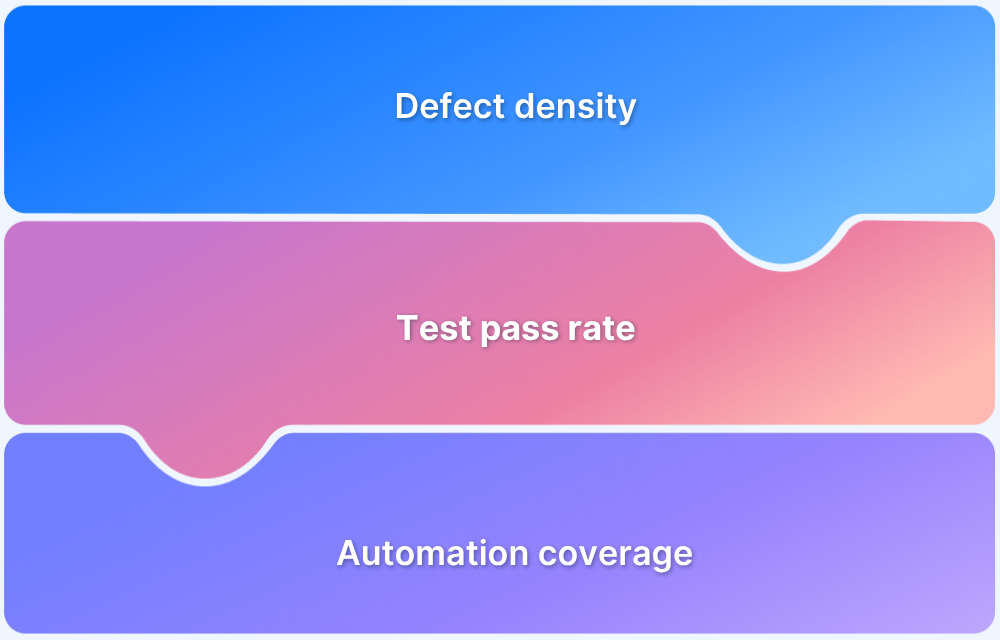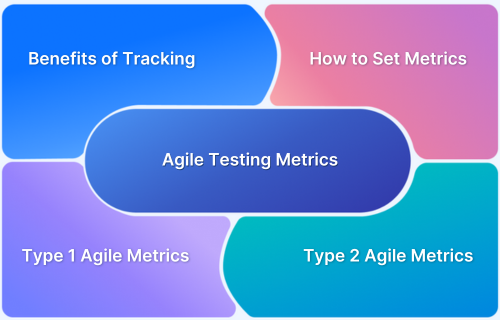How to determine the Right Testing Metrics
By Sandra Felice, Community Contributor - December 26, 2024
Updated on: December 26, 2024
Businesses invest enormous amounts of money, human resources, and time into QA processes. In fact, according to the 12th edition of the World Quality Report 2020-21, QA is a key business priority for organizations to achieve digital transformation. The report also stated that contributing to business growth and business outcomes was the highest-rated objective for testing and QA at 74%.
To evaluate if that investment is yielding decent returns, they need relevant testing metrics – which this article will talk about.
What are Software Testing Metrics?
Software Testing Metrics are measurable indicators that evaluate the efficiency, quality, and progress of the testing process. They provide insights into various aspects, such as defect detection, test coverage, execution progress and system performance, helping teams make informed decisions and improve testing strategies.
A software testing metric is a measure to help track the efficacy of QA activities. Establish the markers of success in the planning stage, and match them with how each metric stands after the actual process.
However, selecting the right testing metrics can be challenging. Often, teams end up choosing metrics that do not align with the business at large. However, without effective benchmarks, stakeholders cannot measure success, identify opportunities for improvements and determine which testing strategies have the most positive impact. Even within teams, metrics are necessary to track individual progress, skill level, and success.
This article will outline a few practices that help management, especially QA managers, determine the right testing metrics.
What are the qualities of a “Right” Testing Metric?
Before figuring out to determine the right metrics, let’s discuss what qualities the right metric should have:
- Essential to business objectives and growth: Key metrics reflect a company’s primary objectives. A typical example would be month-on-month revenue growth or the number of new users acquired. Obviously, metrics will differ between companies, depending on what they want to get out of their software.
- Allows improvement: Every metric that measures progress should have room for improvement. To continue the previous example, month-on-month revenue growth is an incremental metric. If a metric (such as customer satisfaction) is already at 100%, the goal might be to maintain that status.
- Opens the way for a strategy: Once a metric sets a goal for a team, it also inspires them to ask relevant questions to formulate a plan. If revenue has to grow, relevant questions would be: does the product need new features that would inspire more purchases? Is a new acquisition channel required? Has the competition introduced new products or features that customers seem to be drawn towards?
- Easily trackable and explainable: Good metrics are not hard to understand or follow.
Types of Testing Metrics
- Leading Indicators: These metrics track the tasks and activities required to achieve a team’s goals. Examples: tests run by each QA personnel, calls made by each sales rep, etc.
- Lagging Indicators: These metrics measure the actual results to indicate if goals have been met. Examples: revenue earned, new customers that have signed up, etc.
Software Quality Metrics should combine leading and lagging indicators.
How to determine the Right Testing Metrics
- Ask Why: Before deciding on a software quality metric, ask why it matters. QA managers need to ask what the company cares about the most in terms of business goals. Then, they can extrapolate necessary testing metrics.
For example, let’s say that a gaming company focuses on getting users to play for long periods. Under more extensive metrics (number of hours played by each user), QAs would prioritize any bugs that interfere with users’ online experience while gaming. It could be a bug that causes the game to crash or prevents users from upgrading a new character skin. In this case, the testing metrics would be the number of relevant bugs fixed.
Do you know: Essential Metrics for the QA Process
- Look through the customer’s eyes: Whatever the test metric, it should feed into customer satisfaction. For example, let’s say a test metric is the number of bugs detected after release. Why is this important enough to be a metric?
The more bugs that show up after product release, the lower customer satisfaction will be. Measuring post-production bugs is fundamental to keeping customers happy. These bugs need to be identified and fixed at the earliest to prevent the loss of customers due to faulty UI or non-functional features.
Minimize the number of post-production bugs by running all tests on real devices. Often, testers limit their activities to emulators and simulators which simply do not have the ability to accurately replicate real-world conditions. They have major limitations with regard to emulating battery life, incoming calls, native features like pinch and zoom, etc. Naturally, they will fail to detect every bug that may show up on real browsers and devices.
Leverage real device testing with BrowserStack. Access 3500+ browsers and devices to test websites and apps. Take advantage of BrowserStack’s comprehensive debugging options to report, record, and resolve bugs.
Every testing metric worth measuring should relate to customer satisfaction. Customers don’t pay for software they are satisfied with.
- Get Collective Buy-In: The entire team should be in agreement with the metrics selected for tracking. They should have complete clarity on why specific metrics are being tracked. To achieve this unanimity, QA managers should discuss priorities and business goals with their team before deciding on final metrics. At the very least, the team will get their say on what matters. Since QAs fix errors and optimize software to meet customer needs, they are more than qualified to speculate on what is likely to contribute to a good user experience.
- Consider the full usage continuum: Testing metrics should measure software performance across the entire user journey. That means they should look at and track user behavior from login to checkout to exiting the website/app. Users should have the desired experience at every stage: whether they are just browsing or making a transaction. As far as possible, choose metrics that consider the entire usage matrix.
A common example would be testing website speed. It doesn’t seem like a step on the user journey, but it is an integral part of the user experience. In fact, 47% of consumers expect a web page to load in 2 seconds or less. 40% of people abandon a website that takes more than 3 seconds to load.
Website speed must be tested meticulously on different browsers, since the same site may load faster or slower, depending on a browser’s technical specifications. Testers must check the website’s loading speed on different browsers and devices. Run website speed tests on BrowserStack SpeedLab for free to check how a site loads across real, popular browser-device combinations.
Different Software Testing Metrics
Software testing metrics are important for understanding and improving the quality, efficiency, and effectiveness of the QA process.
Here are some key types of software testing metrics:
1. Test Effort Metrics
These metrics measure the time and resources spent on testing activities. They establish baselines and help analyze productivity and efficiency.
Examples:
- Tests per time period = Number of tests run / Total time
- Test design efficiency = Number of tests designed / Total time
- Test review efficiency = Number of tests reviewed / Total time
- Bugs per test = Total defects / Total tests
2. Test Effectiveness Metrics
These metrics show how successful the tests are in finding defects, calculated as:
Test effectiveness = (Bugs found by a test / Total bugs found, including post-release) × 100 Higher percentages mean better test quality.
3. Test Coverage Metrics
Test coverage measures how much of the application has been tested.
Examples:
- Test coverage percentage = (Tests run / Total tests planned) × 100
- Requirements coverage = (Requirements tested / Total requirements) × 100
Read More: How to Improve Automation Test Coverage
4. Test Economy Metrics
These metrics focus on the cost and time spent on testing.
Examples:
- Total allocated cost: Budget approved for testing.
- Actual cost: Money actually spent on testing.
- Budget variance = Allocated cost – Actual cost
- Time variance = Planned time – Actual time
- Cost per bug fix = Total testing cost / Number of bugs fixed
- Cost of not testing: Cost of reworking untested features found defective after release.
5. Test Team Metrics
These metrics help track workload and contributions of team members.
Examples:
- Defects resolved per team member
- Open bugs assigned to each team member
- Test cases allocated and executed per member
6. Defect Distribution Metrics
These metrics help categorize and prioritize defects.
Examples:
- Distribution by cause, feature, severity, priority, or type
- Defects assigned by tester roles (e.g., QA, UAT, end-user)
7. Requirement Defect Density
This measures defects per the requirement to assess how well requirements were understood:
Defect density = Total defects / Number of requirements
8. Test Reliability Metrics
Reliability tracks the consistency of test results over multiple cycles, ensuring tests produce the same outcomes regardless of when or who executes them.
9. Test Cost Metrics
This calculates the total cost of testing, including tools, personnel, and resources.
10. Cost per Bug Fix
This measures the average cost to resolve each defect:
Cost per bug fix = Total testing cost / Number of bugs fixed
11. Time for Testing Metrics
Tracks the duration of the testing phase:
Time for testing = Time from start to completion of testing.
12. Bugs Found vs. Bugs Fixed
This compares the number of bugs identified during testing to those resolved before release. A higher fix rate indicates efficiency.
Read More: How to find Bugs on your Website
13. Defect Resolution Percentage
This shows the proportion of resolved defects:
Defect resolution = (Resolved defects / Total defects) × 100
14. Defect Age Metrics
Tracks how long it takes to resolve defects:
Defect age = Time defect was logged – Time defect was resolved
15. Defect Leakage Metrics
Measures the number of defects found post-release:
Defect leakage = (Post-release defects / Total defects) × 100
16. Test Case Productivity
This tracks the efficiency of test case execution:
Test case productivity = Test cases executed / Time taken
17. Test Completion Status
Monitors testing progress:
Completion status = (Completed test cases / Total planned test cases) × 100
18. Test Review Efficiency
Measures how effectively reviews catch errors before execution:
Review efficiency = (Errors found in reviews / Total errors) × 100
19. Test Automation Percentage
Tracks how much of the testing process is automated:
Automation percentage = (Automated tests / Total tests) × 100
20. ROI of Testing
Evaluates the financial benefits of testing:
ROI = [(Benefits from testing – Cost of testing) / Cost of testing] × 100
Read More: Calculating Test Automation ROI: A Guide
Why use BrowserStack Automate for Test Automation?
BrowserStack Automate is a leading platform for test automation, designed to simplify and enhance your testing process. Here are the key reasons to choose BrowserStack Automate:
- Real Device Testing: Test your application on 3500+ real devices and browsers using BrowserStack’s real device cloud. This ensures accurate testing in real-world environments, eliminating the limitations of emulators and simulators.
- Faster Testing with Parallel Execution: Run tests on multiple devices and browsers at the same time with parallel testing. This significantly reduces testing time and accelerates your release cycles.
- Real World User Conditions: Simulate real user conditions to test your application just as your users would experience it. Catch bugs before they reach your users and ensure a seamless experience.
- Easy Integration with Testing Frameworks: BrowserStack Automate works smoothly with popular test automation frameworks like Selenium, Playwright, Cypress, and Puppeteer, making it easy to integrate into your existing workflows.
- CI/CD Tool Compatibility: BrowserStack Integrate with all major CI/CD tools, including Jenkins, CircleCI, Azure Pipelines, GitHub Actions, and more. This ensures continuous testing and smooth deployment processes.
- Detailed Reporting: Get comprehensive reports and logs for your tests. These insights help you analyze performance, identify issues, and improve the overall quality of your application.
Conclusion
Needless to say, the entire QA process hinges on the use of a real device cloud. Without real device testing, it is not possible to identify every possible bug a user may encounter. Naturally, undetected bugs cannot be tracked, monitor, or resolved. Moreover, without procuring accurate information on bugs, QA metrics cannot be used to set baselines and measure success. This is true for manual testing and automation testing. QA’s can also choose to conduct Cypress testing
Use BrowserStack’s cloud Selenium grid of 3500+ real browsers and devices to run all requisite tests in real user conditions. Manual testing is also easily accomplished on the BrowserStack cloud. Sign Up for free, choose the requisite device-browser combinations, and start testing.




